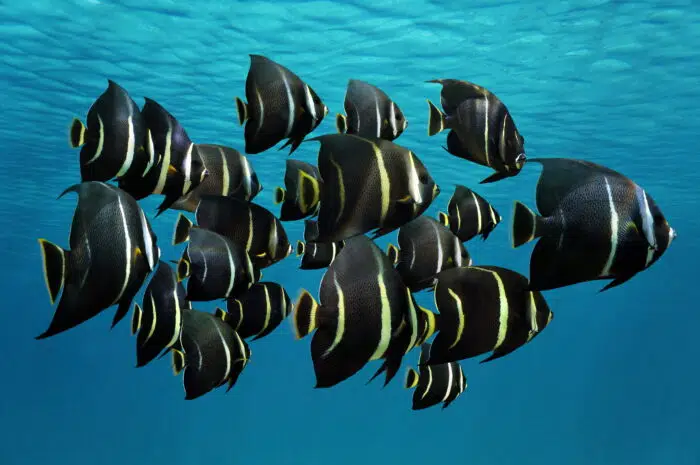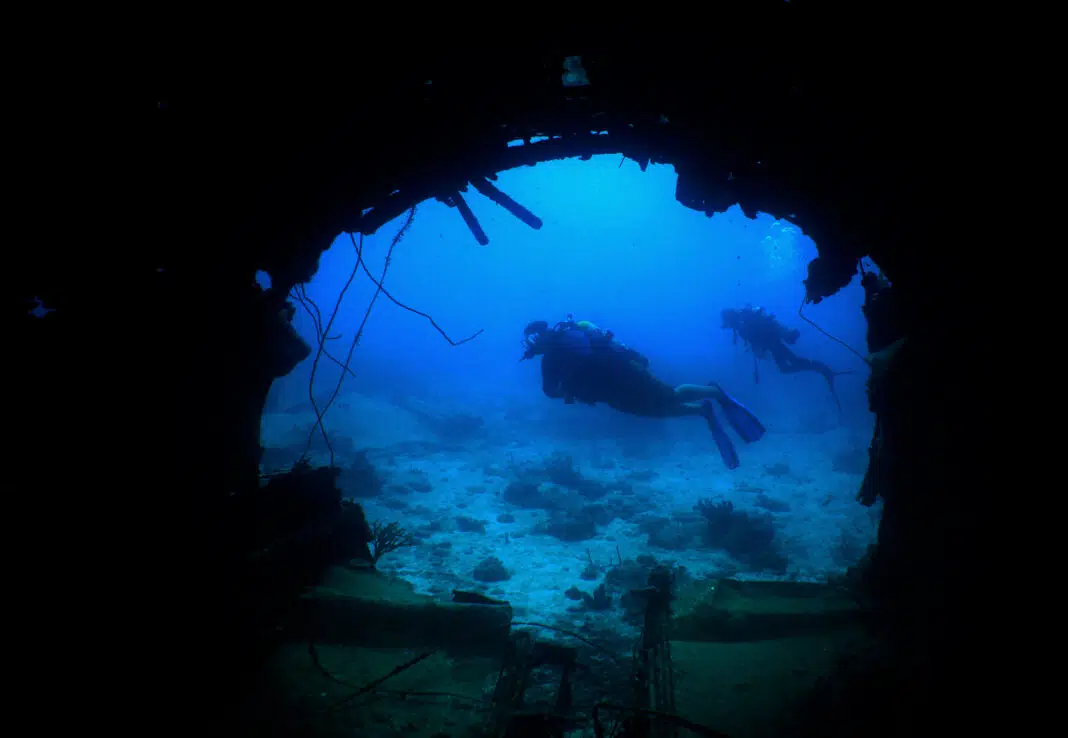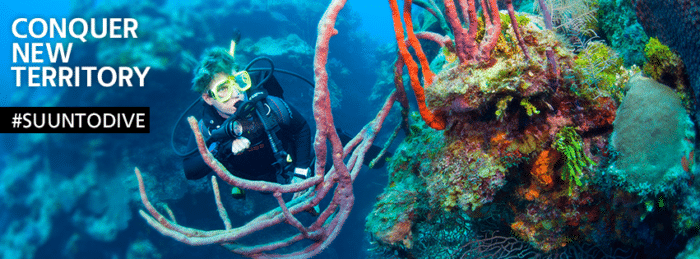Aruba Scuba Diving is part of our Top Dive Sites of the World
Aruba scuba diving is some of the best in the Caribbean. This tiny Dutch island is home to outstanding reefs, amazing wrecks, and rich, diverse marine life, all wrapped up in a warm tropical paradise.
Lying just off the coast of Venezuela, Aruba is blessed with stunning weather. The climate is dry year-round, with invariably sunny crystal-clear skies. Average high temperatures exceed 30C/86f year-round, while average low temperatures are greater than 24.5c/76f year-round. This stable climate makes Aruba a tourist haven, and it can be dived year-round, although the best deals can be had during the “off-season” from April to August.
If you are a fan of wreck diving, then you will have a blast in Aruba. There are tons of different wrecks to experience, from freighters to planes. Some were sunk as reefs, while others were victims of mishaps and international events. If you have a lust for rust, you will not go wrong taking an Aruba Scuba diving trip.
Location
Harbor Tugboat Wreck
The Harbor Tugboat Wreck is one of the easiest and most fun dives of any Aruba scuba diving trip. The wreck lies relatively shallow, resting on the bottom at a depth of 80ft/24m. if you expect an enormous ship with lots of holds, that is not the tugboat wreck. Instead, you will find a wreck that has become heavily encrusted with marine life, including sponges and corals, and is now a virtually integral part of a reef teeming with life.
Due to its relatively shallow depth and easy diving conditions, the tugboat wreck is open to all divers. Slipping into the water at the site, you will find a rich marine life with many different fish species, including french angelfish, clownfish, surgeonfish, and frogfish. You can also find octopuses, moray eels, and more.
Underwater photographers will enjoy exploring all the nooks and crannies in the wreck since it is home to a wide range of critters and macro life making it the ideal site to while the hours away taking macro photos.

Serito Pinnacle
A closely guarded secret amongst the local guides, Serito Pinnacle, is one of the hidden gems of any Aruba scuba diving trip. Located on the island’s south side, the pinnacle lies in blue water on the southeast side of Cabez reef.
The diving is spectacular once you have found a guide and local charter to take you there. The site is a pinnacle rising up from the seafloor. Due to its location, the currents are generally strong here, making it only suitable for advanced divers. The currents bring nutrient-rich waters, which, combined with the lack of visitors, means the area’s reef is pristine and teeming with life.
Exploring the pinnacle, octopuses, shrimps, and nudibranchs are hidden amongst the thousands of reef fish. There are also bigger visitors to the site, and you can regularly see schools of barracuda and jacks, and if you are one of the luckier divers out there, a passing manta ray.
Pedernales Wreck
The wreck of the SS Pedernales is another relic of WWII. The oil tanker was sunk due to an attack by a U-boat in 1942. Lying in relatively shallow water, the Pedernales is perfect for every level of diver and is often the highlight of an Aruba scuba diving trip for beginners. When you dive into the wreck, it is not the entire ship. Following its torpedoing at anchor, the ship was divided into three parts. The middle section was intentionally sunk to become an artificial reef interestingly, the bow and stern were welded together and sailed to the US.
Diving the SS Pedernales can’t be easier; the wreck lies in about 25ft/8.5m of water. Conditions are easy with minimal currents and excellent visibility in the range of 95ft/29m. the wreck is scattered over a wide area and has become home to an enormous amount of marine life.
Exploring the wreckage, the SS Pedernales, you can encounter octopuses and other critters, including moray eels hiding amongst the corals. The reef is teeming with squirrelfish, trumpetfish, Angelfish, and a range of groupers. When exploring the wreck, keep an eye out for the odd turtle known to visit the site and spotted eagle rays that often pass by over the wreckage.
Antilla Wreck
One of the largest wrecks in the Caribbean, no Aruba scuba diving trip would be complete without a trip to the huge 395ft/121m SS Antilla. A German merchantman, the ship was launched in 1939 but ended her life in 1940. At the start of the war, after the Dutch authorities ordered her to be seized while in anchor off Aruba, the crew chose to scuttle the ship, opened the sea cocks, and set the ship ablaze. The SS Antilla eventually went down, settling on her starboard side.
Lying in 60ft/18m of water, the Antilla is perfect for exploration by divers, and on good days snorkels can also have a great experience snorkeling a wreck. There is enormous cargo holds for you to swim through and explore the wreck. Over the years, the wreck has suffered substantial damage from storms, and some parts of the wreck may not be suitable for penetration.
Over the last 70-plus years, the wreck has become an entire ecosystem. The wreck contains sponges, soft and hard corals, and plenty of small critters, including lobsters and octopuses. Schools of blue tangs and other reef fish can be found in abundance, and moray eels lurking in the wrecks, nooks, and crannies. Don’t be surprised if you encounter the odd hawksbill turtle while swimming around the wreck.
Aruba Scuba Diving Wreck Heaven Jane C
The Jane Sea is the star of the Aruba scuba diving scene, and any diving here is a must for any visiting the island to dive. The history of the wreck and how it came to rest on the seabed is somewhat cloudy, with several versions around, including one where the ship was confiscated after being used to smuggle cocaine.
The 250ft/76m freighter lies on the seabed in 99ft/30m of water. Although most dives on the wreck tend to be around a depth of 50ft/15m to 90ft/27m, the wreck is only suitable for advanced divers since currents can be strong at the site, and conditions in the wreck can be a little tricky.
The Jane Sea is an absolute aquarium teeming with marine life, which, combined with the huge cargo hold, makes the ship a pleasure to dive. The ship is encrusted with many hard corals, sponges, and soft corals. This, in turn, plays host to a wide range of marine life, including parrotfish, trunkfish, pufferfish, and wrasses, to name a few.
Couple the rich reef and the strong currents, and there are bigger visitors to the wreck regularly. You can find lots of barracuda dotted around and a host of rays. Keep an eye out for manta rays known to come flying by the wreck. If you are visiting Aruba anytime soon, then make sure you sample the delights of the Jane Sea; you will not regret it.
Click here for more Top Dive Sites of the World
Brought To You By
Our Top Dive Sites of the World guide is brought to you by Suunto. We recommend that you use a Suunto Dive Computer when scuba diving or freediving at one of these dive sites. Suunto is the world’s leading dive computer designer and manufacturer providing diving instruments for recreational, technical, and freediving. You can find out more at Suunto.com.


